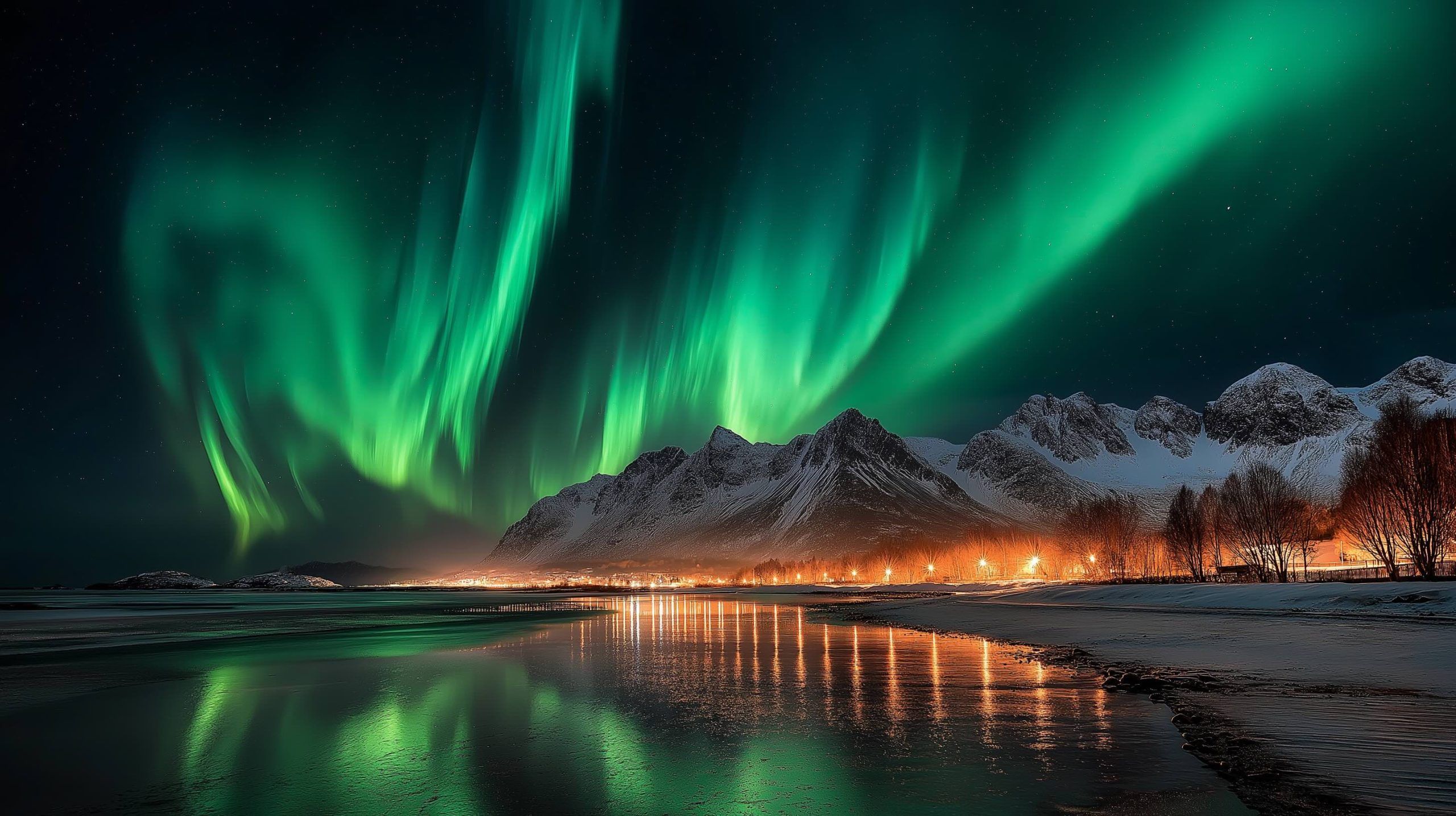Published: November 7, 2025
The Space Weather Prediction Center (SWPC) at NOAA says a coronal mass ejection (CME) is arriving and has a G3 (Strong) geomagnetic storm watch in effect through Nov. 6–7 (UTC), with another, slower CME likely to bring G2 (Moderate) conditions on Nov. 8. Translation: the aurora borealis could dip unusually far south tonight, with the best odds across the northern tier of the United States and parts of the Midwest and Northeast. [1]
Overnight into Thursday, a first wave already pushed Earth to G3 storm levels—a strong event on the 1–5 scale—setting the stage for another widespread aurora chance tonight as the next CME arrives. [2]
What’s new today (Nov. 7)
- Storm status: G3 watch remains in place today after an earlier strong storm; a follow‑up G2 watch has been posted for Saturday, Nov. 8, tied to a second, slower CME. [3]
- Timing windows: Forecasters highlighted Thursday evening into early Friday as the prime window, with an additional pulse possible Friday morning (about 5–11 a.m. ET) as storming fluctuates. Lower-level activity could linger into Friday night as the series subsides. [4]
- Visibility footprint: Based on NOAA’s aurora viewline and national coverage, 20+ states are in play—from the Pacific Northwest across the Plains and Great Lakes into New England—if skies are clear and the CME’s magnetic orientation cooperates. [5]
- Moonlight note: A bright, near-full Moon may wash out faint displays, so look for darker sites to improve your odds. [6]
Where you have the best shot tonight
- Northeast & New England: From Upstate New York through New England to eastern Maine, cloud cover looks comparatively cooperative and the aurora oval may at times dip south enough for a naked‑eye glow on the northern horizon. [7]
- Upper Midwest & Great Lakes:Minnesota, Wisconsin, Michigan and nearby areas are perennial favorites in strong storms; breaks in cloud cover will determine who sees the show. [8]
- Northern Plains & Interior Northwest:Montana and the Dakotas east toward Nebraska/Iowa often score in G3 events; inland Northwest viewers can succeed if they dodge clouds. [9]
- Pacific Northwest & Northern California: Clouds are a wildcard. If they thin, look northward in darker locales away from city lights. [10]
- Mid‑Atlantic (D.C. region): A long‑shot but not impossible during strong peaks. Local forecasters in Washington, D.C. flagged Thursday night and possibly the next few nights if storming persists; photography can reveal faint aurora your eyes miss. [11]
Pro tip: Confirm short‑term guidance with NOAA’s Aurora Dashboard and the 30‑minute Ovation map right before you head out; these update in near‑real‑time as the solar wind conditions change. [12]
When to look
- Prime hours: After nightfall and again around local midnight, with a secondary pulse possible toward dawn depending on the CME’s arrival. In the East, forecasters highlighted roughly 5 p.m.–2 a.m. ET and a potential 5–11 a.m. ET uptick Friday for the ongoing sequence. [13]
- Why timing is squishy: The storm’s intensity depends on the CME’s magnetic field orientation when it hits Earth. A south‑oriented magnetic field (negative Bz) couples efficiently with Earth’s magnetosphere and supercharges auroras; a north‑oriented field blunts them. We only know that orientation once the CME is at the upstream spacecraft near L1. [14]
What’s driving this aurora outbreak
A sequence of recent solar eruptions—including an M7.4 flare on Nov. 5 that launched tonight’s main CME—has Earth in the crosshairs. Earlier strong activity (including X‑class flares) also contributed to last night’s surprise storming. The incoming CME has been modeled and timed for late Nov. 6 into Nov. 7 (UTC), with strong (G3) conditions possible if magnetic alignment cooperates. [15]
This surge comes amid an active phase of Solar Cycle 25, which NOAA previously projected would peak earlier and stronger than first thought—one reason aurora headlines have been frequent since 2024. [16]
How far south could the lights dip?
Forecast maps from NOAA place the aurora viewline across Alaska and much of the northern tier from the Pacific Northwest through the Plains and Great Lakes into New England, with occasional surges pushing auroras into lower latitudes during peaks. National roundups today estimate roughly two dozen states are in play if clouds cooperate and the magnetic field points the right way. [17]
Quick viewing & photography checklist
- Go dark and look north: Pick a site with an open north‑facing horizon away from light pollution. Even faint aurora can look like a subtle gray/green arc low on the horizon before brightening.
- Stay longer than you think: Auroras often pulse; a lull can be followed by a burst 10–30 minutes later.
- Use your phone’s Night mode: Long exposures can reveal color your eyes can’t. A tripod or stable surface helps.
- Mind the Moon: Bright moonlight will mute faint glow—shield your eyes from direct moonlight when scanning the northern horizon. [18]
Could space weather disrupt anything?
Strong (G3) storms rarely cause major terrestrial problems but can briefly affect GPS accuracy, high‑frequency radio, and introduce small voltage corrections in power systems, particularly at high latitudes. That’s on the table again tonight; forecasters are watching. [19]
Live tools to track tonight’s show
- NOAA Aurora Dashboard (Experimental): Tonight/tomorrow viewline maps, animations of the last 24 hours, and what the next 30 minutes may look like. [20]
- NOAA 30‑Minute Ovation Forecast: Rapid updates ideal for go/no‑go decisions. [21]
- NOAA 3‑Day Space Weather Forecast: Plain‑language rationale behind watches and observed conditions. [22]
Outlook beyond tonight
NOAA has also posted a G2 (Moderate) watch for Saturday, Nov. 8, tied to a second, slower CME. The U.K. Met Office similarly notes minor to moderate storms with a chance of strong storming through Nov. 7–8, before activity gradually eases. In short, Friday night into Saturday could still deliver, though intensity should trend lower than tonight’s peak. [23]
Bottom line
- Tonight (Fri., Nov. 7) is a go for aurora hunters across the northern U.S., with G3 (Strong) storming possible. Clouds and the CME’s magnetic orientation will make or break the show in any given place. Check NOAA’s nowcasts before heading out, look north, and be patient. [24]
Sources: NOAA SWPC watches, model and status updates; regional sky and cloud guidance; national aurora coverage and tips. [25]
Related local read: For the Washington, D.C. region, WTOP’s astronomy desk outlines what to watch for and why cameras often see faint aurora before your eyes do. [26]
Editor’s note: Aurora forecasts are inherently uncertain. Use the resources above and refresh them close to your viewing time for the most accurate, real‑time guidance. [27]
References
1. www.swpc.noaa.gov, 2. www.swpc.noaa.gov, 3. www.swpc.noaa.gov, 4. www.washingtonpost.com, 5. www.space.com, 6. apnews.com, 7. www.washingtonpost.com, 8. www.washingtonpost.com, 9. www.washingtonpost.com, 10. www.washingtonpost.com, 11. wtop.com, 12. www.swpc.noaa.gov, 13. www.washingtonpost.com, 14. www.swpc.noaa.gov, 15. www.swpc.noaa.gov, 16. www.swpc.noaa.gov, 17. www.swpc.noaa.gov, 18. apnews.com, 19. apnews.com, 20. www.swpc.noaa.gov, 21. www.swpc.noaa.gov, 22. www.swpc.noaa.gov, 23. www.swpc.noaa.gov, 24. www.swpc.noaa.gov, 25. www.swpc.noaa.gov, 26. wtop.com, 27. www.swpc.noaa.gov










